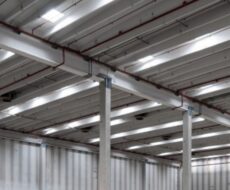
September 21, 2022
Make a seismic upgrade or buy a new warehouse?
How many times during a business lifespan does the need arise to choose whether to intervene structurally on an existing warehouse or to invest by purchasing a new one?

Perhaps the structure is adequate to meet the needs of the activity, but the age of the warehouse and the thought that it may have some gaps in terms of safety lead to having to reflect on what is the best course to prevent certain consequences in the event of a seismic event in order to safeguard the safety of those who work within it.
The “dated” warehouses (this terms refers to structures built prior to 2008), although equipped with regular authorizations, in addition to not having been built according to the current anti-seismic Technical Construction Standards (NTC), may have undergone significant changes over the years (for example “alteration of the external infill for the insertion of a new door”, “widening of the gap in the attic for the assembly of a larger staircase”, “installation of a photovoltaic system on the roof”, “replacement of the overhead bridge crane with greater capacity rate”, etc.).
It is possible that these interventions in the past were carried out without having first carried out an exhaustive structural check because they were considered “minor interventions” but, in the seismic context, the presence of the latter results in an additional risk, creating urgency in intervening on the structure to reduce the potential danger level.
A seismic improvement intervention helps to make pre-fabricated structures safer, but above all it allows to safeguard the human heritage they contain.
Purchasing a new warehouse.
There are several “pros” in purchasing a new warehouse:
- The possibility of having a wider layout and/or surface area that meets the specific needs of the production activity;
- The certainty of satisfying the minimum level of safety required by the NTC;
- The opportunity to be able to select a logistically more effective area than the previous one for the handling of materials and products following urban changes.
Anti-seismic interventions on an existing warehouse.
There are numerous reasons or “whys” that lead to the choice to intervene on the existing pre-fabricated structure:
- The geographical location of the company is known and appreciated by consumers;
- The preservation of existing real estate assets makes it possible to counteract the environmental impact that would occur with the construction of a new building;
- A transfer would result in the interruption of production activity and a consequent reduction in revenue;
- If owned, the current warehouse may have to be put up for sale for the purchase of a new one, thus becoming subject to real estate market trends in that specific historical period;
- The possibility of integrating the warehouse with elements present in new buildings (e.g. photovoltaic panels) at a reduced cost, thus allowing investment in other company projects.
If you want to learn more and discover all the interventions for seismic retrofitting of your warehouse read about our services.
Anti-seismic intervention vs new warehouse: which costs more?
Finally, as far as the entrepreneur’s wallet: for the purchase of a 1,000 square meter warehouse, on average, €350/m2 is spent for the pre-fabricated structure alone, but this figure can reach €750/m2 if the internal finishes are included, systems, flooring, minor works, etc.
The cost of a Seismic Improvement intervention on an existing warehouse is significantly lower than the expense necessary for the purchase of a new prefabricated structure.
In conclusion, if there is no specific need on the part of the company (such as for example the expansion of the surface area of the owned warehouse), the most convenient choice is to seismically improve the existing structure with limited expense, but which ensures a notable increase in safety, something with incomparable value.






